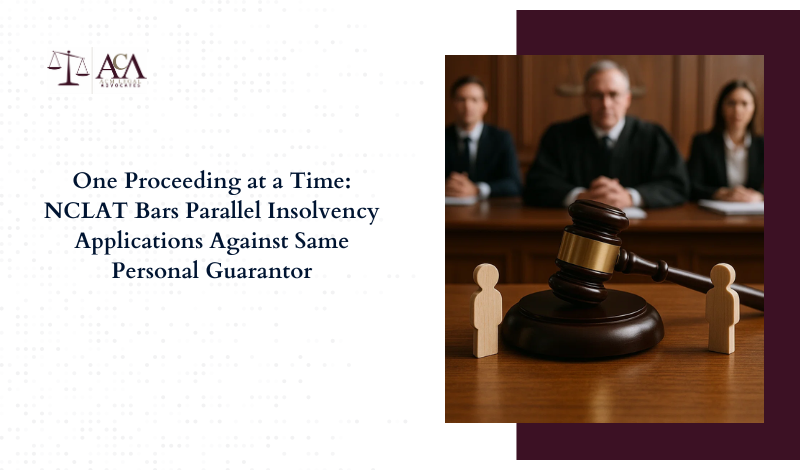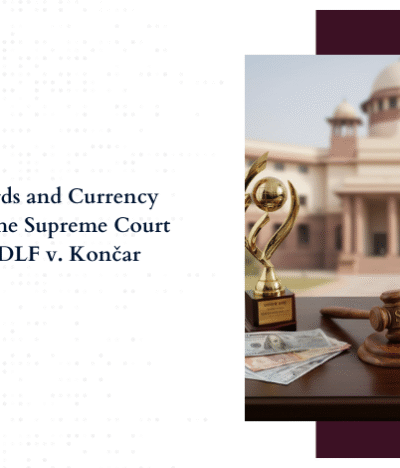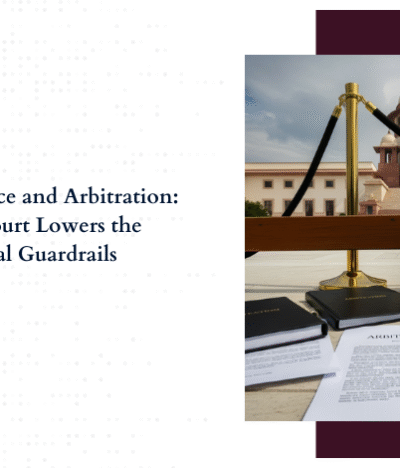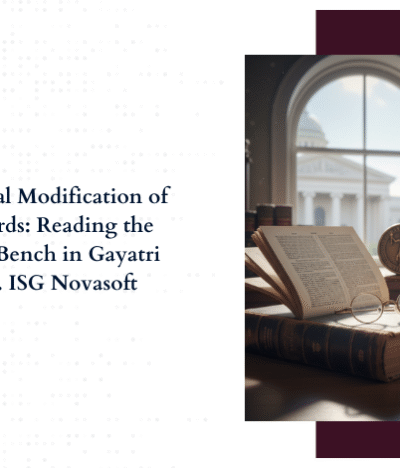I. Introduction
In a significant reaffirmation of procedural discipline under the Insolvency and Bankruptcy Code, 2016 (“IBC”), the National Company Law Appellate Tribunal (NCLAT), Chennai Bench, in Indian Bank v. K.R. Tirumuruhan, dismissed a subsequent insolvency application filed under Section 95 of the IBC against a personal guarantor, reiterating that once proceedings are pending under Section 95, a second application cannot be maintained due to the statutory bar imposed under Section 96.
This ruling strengthens the principle that once an insolvency resolution process (IRP) is triggered against a personal guarantor, any parallel or fresh applications by the same or different financial creditors against the same guarantor must yield until the existing proceedings are concluded. It is a development of considerable importance for both financial institutions and individual guarantors, especially in high-stakes loan default cases where multiple creditors may be in line.
II. Brief Background of the Dispute
The Indian Bank, through its Stressed Assets Management Branch in Chennai, had moved the National Company Law Tribunal (NCLT), Chennai Bench, by way of CP(IB) No. 80/2024, seeking initiation of the insolvency resolution process against the Respondent, Mr. K.R. Tirumuruhan, in his capacity as a personal guarantor under Section 95 of the IBC.
The NCLT, however, dismissed the application as infructuous on 06.01.2025. While doing so, it granted the liberty to the Bank to file afresh at a later date. Dissatisfied, the Indian Bank filed an appeal before the NCLAT, being Company Appeal (AT) (CH) (Ins) No. 150/2025.
However, the Appellate Tribunal refused to interfere with the order of the NCLT and dismissed the appeal by invoking its earlier decision in Indian Bank v. T. Prabhakar, a case involving near-identical facts. There too, the same bank had filed a Section 95 application against another personal guarantor, which was disallowed since proceedings under Section 95 were already ongoing against the same guarantor initiated by another financial creditor (IDBI Trusteeship Services Limited).
III. Legal Matrix: Sections 95 and 96 of IBC
Section 95 of the IBC provides a mechanism for initiating insolvency resolution against personal guarantors. Once a financial creditor files such an application, Section 96 kicks in and creates a moratorium against the personal guarantor from further proceedings — akin to Section 14 of the IBC which applies to corporate debtors.
Importantly, Section 96(1)(b) states that “no fresh application shall be admitted against the same debtor during the pendency of the interim moratorium.” This language serves a dual purpose — it ensures judicial economy and protects the debtor from facing multiple insolvency actions at once, which may otherwise lead to conflicting outcomes and procedural chaos.
The NCLAT’s reaffirmation of this statutory mandate reinforces that the adjudicating authority must reject any second or subsequent application filed against the same personal guarantor if a previous one is already pending.
IV. Observations and Reasoning of the NCLAT
The Bench led by Justice Sharad Kumar Sharma and Technical Member Mr. Jatindranath Swain took note of its own previous pronouncement dated 30.04.2025 in Indian Bank v. T. Prabhakar. In that case, the Tribunal had held that no subsequent application under Section 95 is maintainable once proceedings are already underway.
Applying this ratio to the case at hand, the NCLAT dismissed the current appeal and directed the NCLT to expedite the already pending Section 95 proceedings. The Tribunal emphasized the need for resolution timelines to be respected and discouraged multiplicity of insolvency actions for the same liability under the guise of independent creditor claims.
The Appellate Tribunal’s judgment thus rests firmly on the legal framework under Sections 95 and 96 and aligns with the IBC’s objective of ensuring a unified, comprehensive process for insolvency resolution.
V. The Principle of Non-Multiplicity and Judicial Economy
The NCLAT’s decision underscores a crucial tenet of insolvency jurisprudence — the principle of non-multiplicity of proceedings. While the IBC permits multiple creditors to seek remedy against a common debtor or guarantor, the law discourages overlapping insolvency applications that may impair consistency, waste judicial resources, or frustrate the objectives of a streamlined resolution process.
Once an application under Section 95 is admitted or even pending, it triggers an interim moratorium under Section 96, which statutorily halts the filing or admission of any new application against the same personal guarantor. This is not a matter of judicial discretion — it is a clear statutory command.
In Indian Bank v. K.R. Tirumuruhan, this principle was reiterated with clarity. The Tribunal acknowledged that the financial creditor may have a legitimate claim, but redressal must follow the statutory process. Any inconvenience arising from delay in adjudication or concerns about participation rights in pending proceedings cannot override the legislative framework.
VI. Implications for Financial Creditors and Guarantors
This judgment serves as a reminder to financial creditors — particularly banks and trusteeships — to exercise caution and coordination before filing Section 95 applications. Key takeaways include:
- Single Window Enforcement: Once any financial creditor initiates a Section 95 proceeding against a personal guarantor, others must wait until the process concludes or participate as part of the claims in that ongoing proceeding.
- Creditors Must Coordinate: The IBC doesn’t provide for multiple standalone proceedings against the same personal guarantor. Financial institutions must rely on the existing process and submit their claims to the resolution professional appointed therein.
- Prevention of Forum Shopping: The judgment protects personal guarantors from being subjected to harassment by multiple creditors initiating proceedings in different forums or at different times.
From the guarantor’s perspective, this judgment offers interim protection from repetitive insolvency applications and encourages faster resolution within a single coordinated framework. However, it does not amount to immunity — rather, it prioritizes procedural order over fragmented enforcement.
VII. Comparing With Judicial Precedents
The NCLAT’s approach in this case echoes the rationale behind the Supreme Court’s broader jurisprudence under the IBC — especially on the issue of consolidation and avoidance of parallel proceedings. Although Section 95 is relatively new in terms of judicial interpretation, similar caution has been urged by courts in matters under Sections 7 and 9, where multiplicity of insolvency proceedings against the same corporate debtor has been discouraged.
Moreover, the decision aligns with the purpose of the 2019 amendment, which introduced separate provisions for personal guarantors to corporate debtors, thereby subjecting them to a structured but unified resolution process under Part III of the Code.
VIII. Role of the Adjudicating Authority Moving Forward
The NCLAT’s request to the NCLT to expedite the pending Section 95 proceedings is more than a mere procedural directive — it reflects the legislative intent to avoid unnecessary delays in personal guarantor resolutions. As timelines under the IBC are sacrosanct, the tribunals are expected to strictly adhere to the 90-day timeline for submission of the report by the resolution professional under Section 99.
This decision is also a signal to adjudicating authorities to dismiss infructuous or repetitive filings without allowing legal clutter to derail the process.
Conclusion: One Personal Guarantor, One Proceeding
The NCLAT’s ruling in Indian Bank v. K.R. Tirumuruhan reinforces the legal clarity that once insolvency proceedings under Section 95 IBC are initiated against a personal guarantor, no subsequent application — even by a different financial creditor — is maintainable during the pendency of such proceedings. The bar under Section 96 is unambiguous and non-negotiable.
This judgment balances creditor interests with procedural sanctity, discouraging overlapping litigation and encouraging collaborative resolution. It reaffirms that the IBC is not merely a recovery tool, but a framework governed by order, discipline, and collective action. For creditors, the verdict serves as a critical compliance checkpoint. For personal guarantors, it offers protection from procedural harassment.
Going forward, both creditors and tribunals must take heed — multiplicity is not just inefficient, it is impermissible under the IBC.
Case Citation
Indian Bank v. K.R. Tirumuruhan, Company Appeal (AT) (CH) (Ins) No. 150/2025, decided on 04.06.2025, National Company Law Appellate Tribunal, Chennai Bench.
Top 5 FAQs on Section 95 IBC Proceedings Against Personal Guarantors
1. Can multiple creditors file separate Section 95 applications against the same personal guarantor?
No. Once a Section 95 application is pending or admitted against a personal guarantor, Section 96 creates a statutory bar on admitting any subsequent applications. All creditors must submit their claims in the existing proceeding.
2. What is the legal consequence of an “interim moratorium” under Section 96?
An interim moratorium prohibits any legal action or proceeding against the personal guarantor, including the initiation or continuation of any debt recovery or enforcement proceedings, during the pendency of the Section 95 application.
3. Is there any remedy for a creditor if its Section 95 application is dismissed as infructuous due to pending proceedings?
Yes. The creditor can participate in the ongoing resolution process by filing its claims before the Resolution Professional appointed in the existing Section 95 case. The law encourages a consolidated approach.
4. Can the NCLT allow filing a fresh application after dismissing a Section 95 petition?
Only if the previous application has been disposed of and there is no other pending application. The bar under Section 96 applies strictly during the pendency of an application and does not create a permanent embargo.
5. Does this bar under Section 96 apply only to applications by the same creditor?
No. The bar is against any application — regardless of who the creditor is. Once an application is pending under Section 95 against a personal guarantor, no other creditor can initiate a fresh proceeding until that application is resolved.






